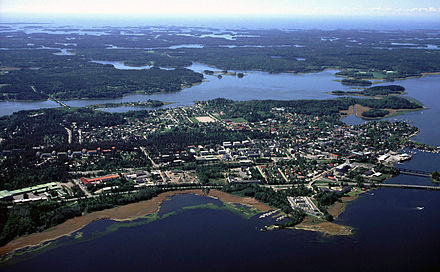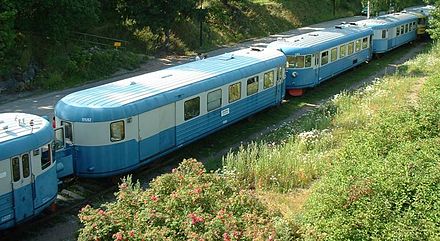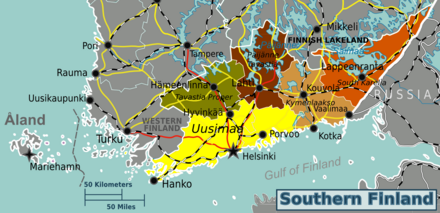Southern Finland - former province in Finland
Southern Finland (Etelä-Suomi, Södra Finland) lies by the coast of the Gulf of Finland, stretching into the lakeland of interior Finland. It is the most populous part of the country, including the urban sprawl around Helsinki.
Regions
Tavastia Proper is the heart of the traditional region of Tavastia (Häme). Here you can find many old churches and manors from the time when Finland was part of the Swedish kingdom, as well as Häme castle.
Päijänne Tavastia is mostly defined by its largest city, Lahti, which is perhaps the most scenic large city in the southern part of the country.
While not famous for its natural attractions, you can find more "man-made" points of interest here than anywhere else. Home to almost a third of the Finnish population, there's always a lot going on in the extended capital region.
Kymenlaakso translates to Kymi valley, and it's bisected by the Kymi river. Most of the Finnish paper industry outside Central Finland and Pirkanmaa are located here and thus it shouldn't come as a surprise that the UNESCO World Heritage site located in this region is a former paper factory.
Located just south of the large lakes, South Karelia is the gateway both to the Finnish Lakeland and Russia.
Cities

- Helsinki (Helsingfors) and its neighbours Espoo (Esbo), Kauniainen (Grankulla) and Vantaa (Vanda)
- Hanko (Hangö) is a recurring favourite with domestic holiday makers due to its nice beaches, climate and traveller-geared services.
- Hyvinkää (Hyvinge), with the Finnish Railway museum
- Hämeenlinna (Tavastehus), has a medieval castle
- Kotka, a port town on the road to Russia, with the Gulf of Finland National Park
- Lahti (Lahtis), a fairly grim industrial town
- Lappeenranta (Villmanstrand), a port town by the lake Saimaa
- Porvoo (Borgå), a city with a very nice old town
- Raseborg contains the picturesque towns of Karis (Karjaa) and Ekenäs (Tammisaari) and also the vibrant village of Fiskars.
Other destinations
- Ekenäs Archipelago National Park
- Gulf of Finland National Park
- Liesjärvi National Park
- Nuuksio National Park
- Päijänne National Park
- Sipoonkorpi National Park
- Torronsuo National Park
- Valkmusa National Park
Understand
Talk
The Uusimaa coast is one of the regions with a big Swedish population. While most of the inland is monolingually Finnish, Swedish speakers are the majority or a big minority in many coastal towns and in much of the countryside near the coast.
Most Finns under the age of 50 speak at least basic and often fluent English, and some tourist-oriented services, especially in the capital region, are available in a range of other languages too. Russian is spoken at many businesses with significant Russian clientèle, mostly by the border and in Helsinki.
Get in
By airplane
 Helsinki is the most important gateway both to Southern Finland and the rest of the country. There are flights from most large European cities and some destinations in Asia and North America by air. Also Lappeenranta in the east of Southern Finland has an airport, to where Ryanair flies from continental Europe.
Helsinki is the most important gateway both to Southern Finland and the rest of the country. There are flights from most large European cities and some destinations in Asia and North America by air. Also Lappeenranta in the east of Southern Finland has an airport, to where Ryanair flies from continental Europe.
By ferry
 Ferries from Stockholm, Travemünde, Tallinn and St.Petersburg and international train and bus connections from Russia. Most cities in Finland have a direct train or bus to Helsinki.
Ferries from Stockholm, Travemünde, Tallinn and St.Petersburg and international train and bus connections from Russia. Most cities in Finland have a direct train or bus to Helsinki.
By train and bus
Trains and buses from elsewhere in the country towards Helsinki also stop along the way in places e.g. Hämeenlinna, Lahti and Kouvola, but if you are coming from the other direction you very likely need to transfer in Helsinki.
By yacht
See also: Boating on the Baltic Sea
The coast is easily reachable from anywhere, and a lovely boating destination. As the region borders the Finnish Lakeland, several inland waterways connect from the north to lakes in the region. Saimaa, and thereby much of South Karelia, is reachable also from the sea, by the Saimaa Canal.
For entry from the Archipelago Sea, see Hanko to Uusikaupunki by boat. The leg from the Archipelago Sea to Helsinki is busy, because of boaters from the metropolitan area spending their holidays off Turku.
Get around

Between cities and major towns you can use trains (VR), while all towns are served by coaches (see timetables at Matkahuolto). For villages not on the main roads you may have to find special arrangements or use taxis.
Hitchhiking is uncommon but possible; be aware that some roads have very little traffic. If you chose smaller country roads, cycling is a possibility and you can camp wild according to the right to access (see that article).
Google Maps includes timetables of trains, long distance buses and local transport of many cities and towns. Other useful route planners are Matka.fi for trains and local buses and Matkahuolto Reittiopas for regional buses.
By taxi
- Smartphone apps: Valopilkku, 02 Taksi, Menevä
By boat
See also: Boating in Finland
The coastal archipelagos and the lakes are very popular boating destinations, and the coast and interconnected lakes lend themselves also to getting around – by cruise, by boat or by canoe. Of the lakes, the Saimaa waterway system is reachable from the sea by the Saimaa Canal, and large enough for any ordinary yacht.
By bike
Several towns in the eastern part of the region (Hamina, Imatra, Kotka, Kouvola, Lappeenranta, Porvoo) use the Donkey Republic bike sharing app and bluetooth, Internet and GPS of your phone. As a member, in Finland for €9 or €18/month, borrowing a bike for less than an 1 hr or 12 hr, respectively, is free. Others pay €1/15 min, €1.50/hr, €4/5 hr, €12/24 hr. Membership must be registered according to your (read: your card's) home country; most countries in western Europe have the system (and USA: one town).
See


- Suomenlinna fortress on an island just outside Helsinki.
- The early 19th century architecture in Central Helsinki.
- The old town of Finland's second oldest city, Porvoo.
- Bengtskär lighthouse by boat from Hanko.
- Imatra rapids, the first major tourist attraction in Finland (now free-flowing occasionally).
- Häme Castle in Hämeenlinna and Raseborg Castle in Snappertuna.
- Verla Groundwood and Board Mill in Jaala, Kouvola; a former paper factory that now is an UNESCO World Heritage Site.
- The Finnish Aviation Museum in Vantaa.
- The Radio Hill in Lahti with its long wave masts from the 1920s.
Do

- Have a fun day at the amusement parks Linnanmäki in Helsinki, Tykkimäki in Kouvola and Puuhamaa in Janakkala, or at the Serena Water Park in Espoo.
- Cruise along Saimaa Canal from Lappeenranta.
- Enjoy a concert in the Sibelius hall in Lahti.
- Travel from Helsinki to Porvoo in an old coastal steamer or from Kerava to Porvoo in a 1960s lättähattu train.
- Visit the limestone cave of Torhola in Lohja.
- Hike along the Salpa trail in Kymenlaakso.
- Shop until you drop at Itis, the largest shopping centre in Northern Europe.
- Walk around in the Aulanko nature park in Hämeenlinna.
- Drive along the King's road, by bike or car.
Eat
Drink
Stay safe
Go next
Southern Finland is well connected to the rest of the country by train, bus or plane and you can drive from Helsinki to most parts of Finland in one day. Of course you can also make a daytrip from Helsinki to Tallinn by ferry.
Southern Finland Province
Date Time:Please wait...Timezone:Europe/HelsinkiCoordinates:60.50, 26.00
Central Finland
Primary administrative division
